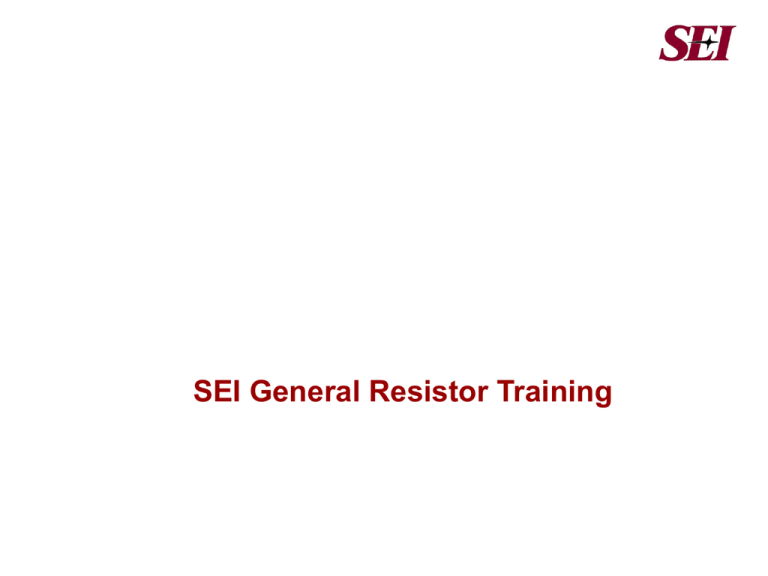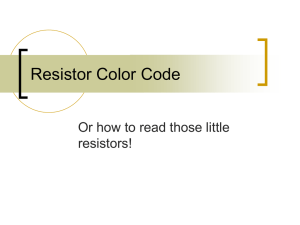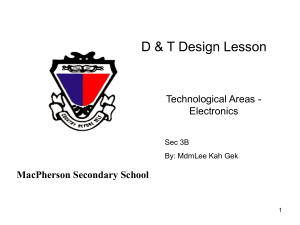Units
advertisement

SEI General Resistor Training Ohm: The Unit of Resistance How much a resistor restricts the flow of current is termed its resistance. This is usually referred to simply as the resistor’s value. The value of a resistor is expressed in the unit of Ohms, and is symbolized by the Greek letter Omega () One ohm (1) of resistance exists when one ampere (1A) of current flows in a material when one volt (1V) is applied across the material. Ohm’s Law V = IxR or R = VI Where: V = Voltage in Volts I = Current in Amps R = Resistance in Ohms or I = VR Resistor Properties - Resistance Value The basic defining property of a resistor is its resistance value Definition: The number of Volts needed to push one Amp of current through the resistor. Units: Ohms () (milliohms, Kilohms, Megohms are commonly used) SEI products range in value from milliohms (E.g. current sense parts like MR and CSR) through the “normal” range of 1 Ohm to 1 Megohm to special high value parts at 4.7 Gigaohms. A data sheet states the maximum and minimum value available. Any value within this range can be made, but we prefer to stick to a limited number of standard values. Resistance Values The value of a resistor is measured in Ohms (). Resistance values on circuit diagrams, legend marked resistors and BOMS are usually written in accordance with the IEC specifications as shown below: 100 = 10 ohms (5%) 10R0 = 10 ohms (1%) 101 = 100 ohms (5%) 1000 = 100 ohms (1%) 102 = 1000 ohms (5%) = 1K 1001 = 1000 ohms (1%) = 1K and so on. Metric abbreviations are used for values not between 1 and 999. The next slide will summarize. E24 values, usually used for 5% and higher tolerance parts, only need two digits and a multiplier to accurately state their values; examples 33 ohms, 47K, 6.8M. E96 values (at least the ones not shared with the E24 values), which are usually used for 1% tolerance product, require 3 digits and a multiplier to accurately state their value; examples 33.2 ohms, 47.5K, 6.81M. Commonly used metric prefixes and their symbols PREFIX+ UNIT Teraohms Gigohms Megohms Kilohms Ohms Milliohms METRIC SYMBOL T G M k m MULTIPLIER 1012 109 1,000,000 1000 1 0.001 LETTER T G M K R R 1.5 is written 1.5 0.01 is written .01 10,500 (10.5k) is written 10.5K 1,800,000 (1.8M) is written 1.8M 0.005 (5m) is written .005 (for some manufacturers is written or marked as R005) Standard Resistance Values: E-24 = 5%. 24 values in every decade E-96 = 1% 96 values in every decade E-192 = .5% & .1%. Some values are not possible in certain products. Resistor Properties - Tolerance This always follows the value when describing a resistor Definition: The maximum error in resistance value at room temperature Units: Percent (%) All processes have some degree of variation and there is a limit to how accurately resistance measurements can be made. This means the actual value may differ from the nominal value, and tolerance is a way of stating the limit on this. In general, tighter tolerances (= lower % figures!) mean higher costs / prices. If the requested tolerance is unavailable, a tighter tolerance alternative can be used. Standard Tolerances include: 20% 10% 5% 2% 1% M K J G F Rare Rare Common Common Common 0.5% 0.25% 0.1% 0.05% 0.02% D C B W P Semi-precision Semi-precision Precision Precision Precision Resistor Properties - TCR TCR stands for Temperature Coefficient of Resistance Definition: How much the resistance changes with temperature across a given temperature range Units: Parts per million per degree C (ppm / °C) (1ppm = 0.0001% over a 100 °C change) The resistive properties of all materials vary with temperature. Careful material selection and processing can minimize this. This is generally more of an issue for precision resistors. These are often available in a range of TCR values - the lower the TCR, the higher the cost / price. Resistor Properties - Power Rating Any resistor functions such that it limits current flow while dropping voltage. It does this by changing some electrical energy into heat. The amount of energy the resistor is capable of safely changing into heat is called its power rating. Definition: The maximum power which can be dissipated in the resistor at a certain ambient temperature is the resistor’s power rating. Units: Watt (W) = 1 Joule / 1 second If a resistor gets too hot it can a) change value, b) become unreliable or c) burn or damage the circuit board and surrounding product. This sets a limit on how much electrical power can be allowed to turn into thermal energy in a given time. The power rating relates to continuous dissipation for an indefinite time. Resistors can dissipate more power if the time is limited to a fraction of a second or a few seconds, known as pulse power. Resistor Properties - Overload A duration from a fraction of a second to several seconds Definition: The standard overload test is usually 6.25 times the rated power or 2.5 times the maximum allowable voltage, whichever is the lesser, for 5 seconds Units: Percent (%) The standard overload test subjects the resistors to a power greater than their maximum continuous power rating. This can be used to remove faulty components during manufacture, and helps provide an indication of the ‘Pulse Withstand Capability’. The overload performance is given as a change in resistance between the value before and after the test. Overload powers and times do vary depending upon the component type or on customer request. Resistor Properties - Fusibility Sometimes a resistor needs to fuse, safely switching off a faulty circuit Fusible resistors are designed to fail permanently open circuit when excessive power is dissipated in them. Many products will fail in this manner – what makes a resistor “fusible” is that the conditions of safe and certain fusing are specified and controlled. TIME Pr Pmin Pmax Tmin Tmax Rated power Minimum power for guaranteed fusing Maximum safe fusing power Minimum fuse time Maximum fuse time Tmax Tmin POWER Pr Pmin Pmax Notes: Multiple curves may be shown for different value ranges – lower values have higher Pmin. On some data sheets the POWER and TIME axes are transposed. Sometimes only the Tmax curve is shown. SEI Part Number Construction: Series Name – Ohmic Value Tolerance Spare Generic Examples : Exception : Example: CSR1 .003 1% R WW3 10K 1% R Some resistors also have a ‘TCR’ code inserted after the ‘Series Name’ RN1/4 T9 10 .1% R Key Questions to Ask Customers •What type of resistor? Mounting - Through-hole / Surface Mount / Non-PCB Technology - Metal Film / Metal Oxide / Wirewound / Thick Film •What value + tolerance? •What TCR? •What rating? Power rating Maximum working voltage (applies to higher values only) •What physical size? •What competitor’s product is it to replace, if any? (Get manufacturer + type) •What volume of product is required? EAU •Do any special requirements apply? (High Voltage, Moisture Sensitivity, low noise, pulse power) Types of Resistor There are TWO main types of resistors; * Fixed These resistors have their value set during manufacture and it cannot be changed. All of SEI’s resistors are Fixed Resistors. * Variable These resistors are designed so that their resistance values can be changed easily, such as potentiometers. SEI does not manufacture this type of resistor. SEI Resistor Termination Technologies These are divided into three main types; * Through Hole (or “leaded” or “axial”) * Surface Mount (or “SMD”, or “SMT”) * Non-PCB (Specials and high power resistors) Circuit board Through Hole Surface Mount SEI Resistor Technologies Through Hole Wirewound Resistance wire Ceramic core + caps + leads Film (Metal/Metal Oxide/Carbon/Thick Film) Resistive film with spiral cut SEI Resistor Technologies Surface Mount Chip ( Thin Film ) Insulation Resistance film Ceramic chip Chip ( Thick Film ) Insulation Resistance film Ceramic chip Formed Leads SEI Resistor Technologies Non-PCB (Specials and high power) Thick Film on Steel: Chassis Mounted: Applications for Resistors CIRCUIT FUNCTION APPLICATION EXAMPLE To limit current in a circuit To measure current in a circuit To generate heat To remove electrical energy To divide a voltage To set the gain of an amplifier To set a time delay To set frequency of an oscillator To protect against surges To absorb unwanted signals To measure temperatures LED illuminated main switch Car window motor control Hair dryer, air freshener High voltage capacitor discharge in TV High voltage supply in X-ray equipment Car audio amplifier Test equipment - pulse generator Test equipment - signal generator Electronic electricity meter High speed computer system Thermal trip in motor controller SEI Major Product Series - Surface Mount SERIES TYPE DESCRIPTION RMC RGC HMC HVC FCR Thick Film Thick Film Thick Film Thick Film Thick Film General Purpose Chip Resistor Semi Precision Thick Film High value chip - to 50G High voltage chip - to 3.5kV (NEW) Trimmable Chip RNC TTF Thin Film Tan Film Precision Chip Resistor Moisture Sensitive Precision Chip Resistor CSR CSRL CSRF CSRN Thick Film Metal Foil Foil on Ceramic Thick Film Low value current sense resistor Lowest value current sense (.001 and .002) Low value current sense (.003 to .010) Low value current sense, narrow termination RAV/RAF Thick Film RAC Thick film Convex / Flat termination chip array Concave termination chip array SM Surface mount wirewound - to 3W Wirewound SEI Major Product Series - Through Hole (Film types) SERIES TYPE DESCRIPTION RN Metal Film UP Metal Film RS Metal Oxide ASR/SPR Metal Oxide RSPF/RSPL Metal Oxide FRN Metal Film Fusible JW Metal CD Metal Film General purpose / Semi-precision Ultra precision General purpose Anti Surge / Discharge Path Flameproof power RC CF Carbon Comp Carbon Film General purpose General purpose WRF GP WW MR/TMR NSP CB VM VER EL/CEL KAL Wirewound Wirewound Wirewound Wirewound Wirewound Wirewound Wirewound Wirewound Wirewound Wirewound Consumer grade, conformal coated Commercial grade, conformal coated General purpose / precision Low value, current sense, and four wire Ceramic housed, consumer grade Ceramic housed, general purpose, and other versions Ceramic housed, vertical mount, and other versions Vitreous Enamel conformal coated Commercial power Aluminum housed Jumper wire Zero Ohm Jumper Applications - Industrial RCD (RCCB / GFCI) Test resistor Voltage dropper RS / WW / RN MOTOR DRIVE Braking Current Sense NSP / CB / VM CSR /CSRN /CSRL /CSRF Inrush limit WELDING PSU Output stage ASR / SPR / RSPF Input stage WRF / GP / WW Precision RN / UP / RNC/TTF/WW LIGHTING BALLAST PROCESS CONTROL Applications - Medical DEFIBRILLATORPulse protection RSC / ASR / RSPF MONITOR High sensitivity amplification HMC / RNC / TTF X-RAY High voltage control ASR / SPR / RSPF DEFIB, MONITOR, X-RAY Power supply regulation CSR / MR / LCB / LVM Applications - Automotive IGNITION Pulse suppression RC / WW / ASR / SPR Current sense CSR / MR / LCB / LVM Output stage ASR / SPR / RSPF WINDOW LIFT SEAT / STEERING / MIRROR POSITION WIPERS POWER DISTRIBUTION (DC/DC CONVERTORS) HID LIGHTS







